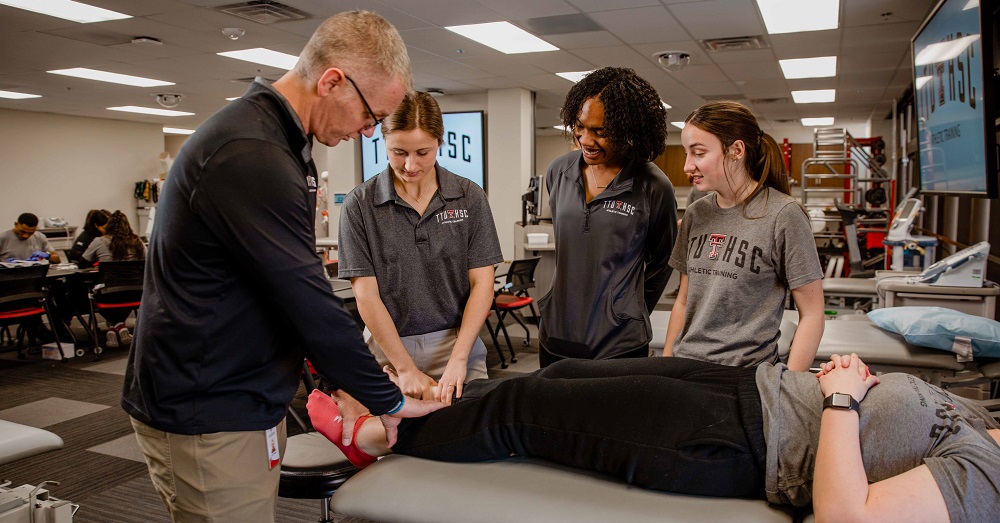Growth and Versatility in Athletic Training as a Medical Profession
An Expanding Variety of Workplaces are Discovering “There’s an AT for That”

Athletic training is projected to grow by 17% through 2031
After Buffalo Bills’ safety Damar Hamlin’s cardiac arrest on the field in January, most people know that athletic trainers do far more than ice or bandage players’ injuries during a sporting event. The Bills’ athletic trainers’ life-saving intervention for Hamlin brought high-profile attention to this usually low-profile medical profession.
Even before that notoriety, the occupation was seeing exponential growth and increased interest. The U.S. Bureau of Labor Statistics projects that jobs in athletic training will grow by 17% through 2031, much faster than average for all occupations.
Larry Munger, Ph.D., LAT, assistant program director for the Master of Athletic Training Program at the Texas Tech University Health Sciences Center (TTUHSC), said the work of athletic trainers happens mostly behind the scenes. Like a lot of others in the profession, he’s fine with that.
“Someone gets hurt, we might run out there,” Munger said. “But really, we're involved in all phases of athletic or athletes' health care.”
Athletic trainers coordinate the athletes’ overall health care plan under the supervision
of a licensed physician. That plan usually starts with a pre-participation physical
exam and movement assessment.
“The best athletes are the available athletes,” Munger said. “You can be the most
talented athlete, but if you can't play because of injury, you're not helping out
your team. And so, we try to do things to make sure that they stay healthy.”

Frank Perez, MAT, ATC
Frank Perez, MAT, ATC, assistant athletics director of Texas Tech University Sports Medicine and athletic trainer for track and field athletes, says the focus on injury prevention is one aspect of the profession that sets athletic trainers apart from fitness or personal trainers.
“That's where our part and where our communication happens- with strength and conditioning, with our coaching staff- to make sure that we can keep those players available,” Perez said. “We need robust athletes that are adaptable. And so that's part of our deal.”
Athletic trainers are highly qualified health care professionals. In accordance with their education, training and the state’s statutes, rules and regulations, athletic trainers are often certified by a national governing body. A recently added requirement for certification is graduating from an accredited athletic training master’s degree program.
Munger says the master’s program at TTUHSC was one of the first in the country when it opened 23 years ago. “We try to hold a class to about 20 to 30,” he said. “And so, we're one of the larger programs.” The TTUHSC master’s program has graduated more than 400 athletic trainers to date who are working in settings nationally and internationally at all different levels.

Job opportunities for athletic trainers have grown to include an increasing variety of settings
Over the last few decades, job opportunities for athletic trainers have grown to include an increasing variety of settings beyond sports and clinical environments. Munger notes alumni from the TTUHSC Master of Athletic Training Program are working in corporate and industrial settings, with police and fire departments, in military settings and with NASA, to name a few examples.
Performing arts is another area where athletic trainers are in demand. After completing his MAT at TTUHSC and beginning his career in collegiate athletics, Perez worked with a cast of performers for Cirque du Soleil in Las Vegas for a few years. He said the unique perspectives he gained from that experience help in his current work with Texas Tech student athletes and students from the TTUHSC’s athletic training master’s program.
Perez said the demand for athletic trainers will continue to grow, especially as society adopts broader definitions of athletes, teams and performance.
"We're all athletes, you know,” Perez said. “What we do is a part of our function, whether that's as simple as getting up and out from a desk and walking around, on stairs, to your full-fledged athletes. Athletic trainers have specialized training to bring people back into specific issues or specific functions of their life. And I think that can be utilized even more.”
Related Stories
TTUHSC School of Nursing Celebrates 10 Years of the Veteran to BSN Program
The TTUHSC School of Nursing recognized the 10-year anniversary of the Veteran to Bachelor of Science in Nursing (VBSN) program during the fall 2025 commencement ceremonies held Dec. 13 in Lubbock, Texas.
Lubbock ISD Middle School Students Become Docs for a Day
Lubbock Independent School District students from Atkins Middle School, McCool Academy and Evans Middle School became doctors for a day as the TTUHSC Student National Medical Association (SNMA) hosted Docs for a Day Nov. 10.
From Classroom to Clinic: Building the Future of Speech-Language Pathology
The Clinical Experience Course in the Speech, Language and Hearing Sciences program at TTUHSC provides students with hands-on, practical application of the theoretical knowledge learned in the classroom.
Recent Stories
Making Mental Health a Priority in the New Year
Sarah Mallard Wakefield, M.D., a psychiatrist with Texas Tech Physicians, talks about strategies to combat widespread and growing anxiety.
TTUHSC Cancer Researcher Honored by National Academy of Inventors
C. Patrick Reynolds, M.D., Ph.D., director of the School of Medicine Pediatric Cancer Research Center at TTUHSC, has dedicated his life as a researcher to developing treatments for childhood cancers.
TTUHSC School of Nursing Celebrates 10 Years of the Veteran to BSN Program
The TTUHSC School of Nursing recognized the 10-year anniversary of the Veteran to Bachelor of Science in Nursing (VBSN) program during the fall 2025 commencement ceremonies held Dec. 13 in Lubbock, Texas.
